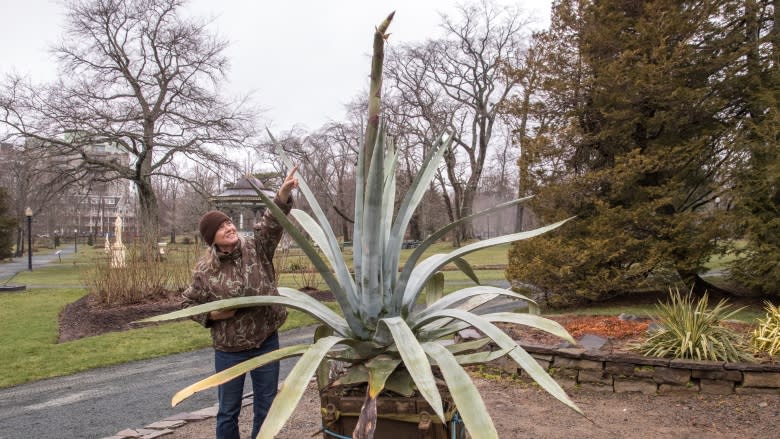Halifax's massive century plant stops growing because it's too cold
A massive century plant at the Halifax Public Gardens is protesting Nova Scotia's "spring" weather by refusing to grow.
The Agave americana's recent growth spurt forced gardeners to lug the more than 450-kilogram plant out of the greenhouse earlier this week.
Its flowering stalk, which resembles a giant asparagus spear, is about 1.5 metres tall and had been growing more than 15 centimetres a day. That is, until it got acquainted with Halifax's April temperatures.
"She kind of stopped growing once it went out in the cold and due to the temperatures that were forecasted for the weekend we decided to just cover it up with this kind of like a Thinsulate blanket," said horticulturist Heidi Boutilier.
The mother plant has also been covered with a blanket with incandescent lights underneath to keep it warm.
Boutilier said the plant likely won't grow while it's under wraps, but the covering will "keep it from going into shock."
The plant is about 25 years old and only blooms once in its lifetime. Once it does, it dies.
When the stalk reaches its full height, it will look less like an asparagus and more like a sparse, lanky coniferous tree that's between six to 12 metres.
While the century plant can handle single-digit temperatures, Boutilier said it could have an impact on when — or if — it blooms.
She said she doesn't know how long the plant will live once it fully blooms.
"It's hard to say exactly because especially with the cold weather it slows everything right down, but if she was in a normal environment, four or five weeks, six weeks," said Boutilier.
The member of the agave family produces liquid that can be used to make mezcal liquor, and is native to warmer climates like Mexico. While the Public Gardens grows a handful of agaves, it's been more than a decade since one bloomed.
Typically, century plants are planted in the gardens in May and stay there until October, but Boutilier said gardeners simply ran out of space in the greenhouse with this one.
"We had no choice but to take it outside," she said. "It was either cut the stalk down or take it outside … we wanted to give it a chance to do whatever it was wanting to do."
The massive plant has been drawing curious onlookers to the gardens.
"I was over there a few times last week and I noticed lots of people coming to see it, taking pictures, mothers bringing their children to see it. It's a very educational thing as well, right, so there's been a lot of activity, lots of questions," said Boutilier.
She hopes the covering will come off on Monday when temperatures reach double digits, and that the plant will get back to what it does best — grow.
"I'm very hopeful. I think plants are very resilient," she said.



